For most of us who carry a concealed firearm, just getting the firearm from the holster and getting off that first shot is a challenge in itself let alone to achieve the degree of accuracy and precision these shooter obtain (or have obtained), and we are usually encumbered by a number of factors that complicate the draw stroke.
In this article, I hope to present the majority of things that (I feel) complicate the draw stroke. This article is not to make you a better shooter but, hopefully identify some factors that you and I must work around to simply present the concealed carry firearm, and in some cases, an open carry pistol or revolver.
While I may mention products in this article, those products are not the final say nor do I imply that they are. It is up to the individual to decide what products may fill their need to simplify the draw stroke yet allow for enough security to maintain their firearm on their person.
HOLSTER:
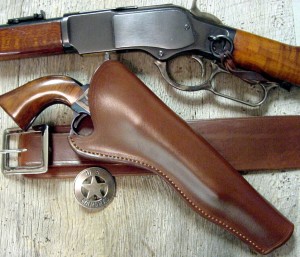 The Cochise Leather Company website (http://www.cochiseleather.com/western-gun-leather-history.aspx) provides a nice history of Western gun gear, if you are interested in the history of such.
The Cochise Leather Company website (http://www.cochiseleather.com/western-gun-leather-history.aspx) provides a nice history of Western gun gear, if you are interested in the history of such.
The purpose of the holster is, essentially, to contain the handgun with some degree of security for the firearm and the user of the firearm. As a former LEO, I wore a “Security” holster that not only contained a pistol or revolver, but added a degree of security against the gun-grabbing criminal element or loosing the sidearm when tussling with a bad guy while trying to subdue him (or her). The security holster also meant that I had to perform certain actions in order to release the hand gun from its container. While I won’t go into those actions, let it be said that an inordinate amount of training was required to perform them in a proficient manner.
As a concealed-carry citizen, my thoughts go toward using a holster that still houses the hand gun and offers a degree of security, but is not as secure as the holster used when I was a LEO. Should I decide to open-carry, my security needs for a personal sidearm increase and I’ll just leave it at that.
Let’s talk about some holster types and options; all of which have an impact on the draw stroke.
IWB Holster:
IWB (Inside-The-Waistband) holsters come in a wide variety of materials and sizes. I include Belly-Band holsters and holsters like the Smart Carry because these holsters can be contained within the trousers.The most popular of the IWB holster, these days, is the hybrid holster; a holster constructed of leather (or other material) and Kydex. Attachment to the belt may be via metal or polymer clips or leather loops. There are, of course IWB holster made completely of leather and completely of Kydex. In most cases, these holsters are form-fitted to a specific firearm, but may also serve other firearm the same family well. For example; a holster fitted for the Glock 17 pistol will also serve as an excellent container for other Glock pistols of shorter barrel lengths, a holster fitted for a “Government” length 1911 is also compatible with “Commander” and “Officer” length 1911 pistols,
While there are some excellent IWB holsters, there are also some poor ones and they should be avoided at all cost. A good IWB holster should not collapse when the hand gun is drawn from the holster and prevent smooth re-holstering of the handgun. There are numerous IWB holsters that are not reinforced at the mouth, which help to prevent the holster from collapsing. The reinforcement is usually an additional layer of stitched leather and may or may not contain a metal (or polymer) band for additional strength.
Additionally, there are universal hand gun IWB holsters that fit a wide variety of firearms and are made of some sort of fabric material. While they are suitable, for the most part, of containing a hand gun, there are far inferior to others in the security department.
IWB holsters can be worn in many positions on the body with the strong side, behind-the-hip and appendix position being two of the more popular.
A good IWB holster holds the hand gun close to the body. Its purpose is concealment, and in doing so, complicates the draw stroke because the operator may have to adjust the body, shooting hand, and arm unnaturally to properly grip the handgun to perform the draw stroke.
Although I have both leather-only and hybrid IWB holsters for a number of handguns, the hybrid holster provides the best handgun concealment and security, in my opinion. Hybrid holsters, in most cases, also provide better options for ride height and cant (see Cant and Ride Height). Also, some IWB holsters are offered with thumb-breaks or other retention methods (see Retention Devices).
OWB Holster:
The OWB (Outside-the-waistband) holster is one that is obviously carried outside of the pants. While there are other holsters that allow for OWB carry, the OWB holster that I am addressing is one that is mounted on a belt and that would be carried on the strong side. Obviously, an OWB holster can be concealed under a garment or not. Note that I am working with concealed carry as opposed to open carry.For the best concealed carry, an OWB holster should have a low profile and provide adequate security for the handgun. While there are many OWB holsters, the “pancake” style provides the lowest profile regardless of the firearm housed, in my opinion.
OWB holster are available in different ride heights while other hybrid OWB holsters may be adjustable for ride height and cant. With most OWB holsters, cant is usually built in and is usually no greater than 15-degrees (known as the FBI cant). I usually like the butt of my handgun to be as close to the beltline as possible and try to select a holster that accommodates the size of the pistol and my body shape. See Ride Height for more information.
An OWB holster, like an IWB holster, should not collapse and prevent the easy holstering of the handgun. Some OWB holsters incorporate reinforced mouths to ensure that the holster does not collapse while other prevent holster collapse by their design and/or material
OWB holsters of the type discussed are also offered with retention devices to aid in securing the handgun (see, Retention Devices). For an open-carry holster, I would only wear one with some sort of retention device. However, a retention device may also be suitable for OWB concealed carry.
As a side note about a recent training course, I wore an OWB holster for the Ruger SR1911CMD-A from Leather Creek Holsters. This holster is excellent in retention, form, and function and I would not hesitate to use it for OWB concealed carry. As a primary OWB open-carry holster; however, I don’t consider it because it lacks a retention device that I favor – a thumb break, and which is a device that some say impeded the draw. As an OWB concealed-carry holster, it performed flawlessly.
An OWB belt-holster should also be constructed as to limit movement about the belt as much as possible. We have enough to worry about during the draw-stroke without worrying about holster shift.
There are also paddle holsters; a holster that is OWB but has a large paddle that is inserted into the waistband to hold it in place. This style of holster was (and still is) popular on the television series N.C.I.S. and never did one come out of the pants unintentionally as has happened in real life. Again, we have enough to worry about during the draw-stroke without worrying about holster shift.
Cross-Draw Holster:
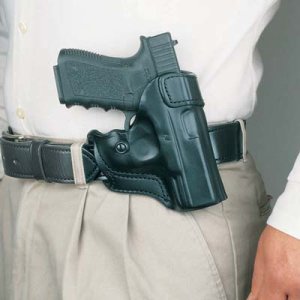 Cross-draw holsters are shunned by many; they do have their advantages as they do disadvantages. There are cross-draw holsters for IWB and OWB carry with OWB carry being the most common.
Cross-draw holsters are shunned by many; they do have their advantages as they do disadvantages. There are cross-draw holsters for IWB and OWB carry with OWB carry being the most common.
Cross-draw holsters should follow the same principles as IWB and OWB holsters; not collapse and provide adequate security for the firearm.
One guiding principle that I have read concerning holsters is that you should wear the holster on the same side as you do when firing a long gun. The principle behind this is that your arm travels less distance when transitioning from a long gun to the sidearm and vice-versa.
One of the arguments against the cross-draw holster is that you can sweep yourself, or someone else, with the muzzle of the handgun. I can say that is a good argument. With that said, I find myself among the populace of firearm handlers who shoot a handgun right-handed (the majority of the time) and shoot a long gun left-handed; therefore, a cross-draw holster (for me) has more advantages than disadvantages.
Drawing the handgun from a cross-draw holster is more complex than that with a strong-side holster and a lot (if not all) completion events disallow cross-draw holster use.
Most tactical rigs are set up with cross-draw holsters, but how often when in public do you wear your tactical rig?
Shoulder Holster:
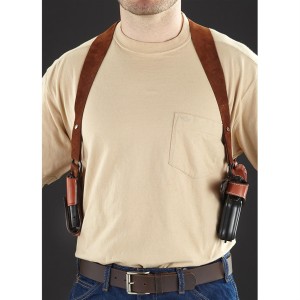 Shoulder holster became very popular because of television shows like Miami Vice and others. The DiNozzo character, played by Michael Weatherly in the hit series N.C.I.S, used a shoulder holster in the early beginnings of the series and occasionally since.
Shoulder holster became very popular because of television shows like Miami Vice and others. The DiNozzo character, played by Michael Weatherly in the hit series N.C.I.S, used a shoulder holster in the early beginnings of the series and occasionally since.
Shoulder holsters have been equated with large egos and double shoulder holsters with doubly large egos.
Shoulder holsters can hold large and extremely small handguns. Horizontal shoulder holsters are favored over vertical except for handgun with long barrels.
Drawing a handgun from a shoulder holster shares the same concern as do cross-draw holsters; sweeping yourself or someone else the muzzle of the firearm. With that concern in mind, a horizontal should holster automatically place the muzzle in the direction of someone behind you.
The shoulder holster obviously needs to provide for security of the firearm and most do with a thumb break, retention strap, or simply holster tension. An addition, the holster may be attached to the belt in some fashion or another to keep the holster stable.
There are also variations of the shoulder holster in the form of t-shirts or belly-band type holsters. Most are regarded as adequate for sub-compact and compact pistols and revolvers for deep-concealment but are hardly adequate for easy access to the firearm.
In most cases, drawing from a shoulder holster requires the use of both hands (depending on the type of shoulder holster). This, of course, exacerbates the complexity of the draw stroke from these holsters.
Shoulder holsters, like other holsters, are available in leather, Kydex, and hybrids. They can also take the form of “Chesty” holsters that place the holster across the chest in some sort of rig. Many outdoorsmen like the “Chesty” holster for quick access to the handgun for hunting or protection from 4-legged critters that also like meat on their table.
Shoulder holsters may also incorporate an off-side ammunition carrier in the form of a single or double pouch magazine holder or, in the case of a revolver, a single or double speedloader or speed strip holder. These ammunition carriers may also have the capability of attaching a strap to attach to the belt and which keep things from flopping around.
As with cross-draw holsters, and for me, a shoulder holster places the butt of the sidearm on the same side as my long gun (since I shoot long-guns left handed) and transitioning from the long gun to a shoulder-holstered firearm is quite quick. I also have a shoulder holster for the SIG Sauer P239 that I carried for quite a while; it also works with some other pistols that I have. I have worn the shoulder holster beneath an unbuttoned shirt and when bending over, the movement of the shoulder holster forward helps to alleviate printing from the rear. While understanding the pros and cons of shoulder holster, I find it useful in some tactical situations and I have no real concerns about housing a handgun in a shoulder holster, because I have trained with it and understand its limitations.
Competition Holster:
I will make this sub-topic short. A holster designed for competition should not be used for everyday carry. That is not my opinion alone, but is the opinion of experts that are held in high regard – including competition shooters.
Range Holster:
I don’t own a range holster, but I do have holsters that I use at the range. They are my everyday carry holsters.
I understand that some do not have a holster for, say, their home defense handgun and simply purchase a holster like an Uncle Mikes or other brand to wear at the range. Others buy a very costly, highly custom holster to show off their pride in their gear. While I understand these things, for those of us who carry on a daily basis, our carry gear is what we should be training with. I have two holsters that I regularly carry the 1911. When I am training from the draw, one of these holsters will be in place as they are the most familiar to me. One is an IWB holsters and the other an OWB holster. After building my own holster drawer, I have finally settled on a holster brand that regardless of the pistol carried allows me to adjust the cant and ride height to my liking and is close to the same for every pistol. I have enough to worry about without having to learn the holster.
Holster Break-in:
Most leather-based holsters take some break-in time. In most cases, the holster is too tight with the handgun holstered. Rather than say do this or the other to break in your holster, I’ll lean you toward the manufactures recommendations.
With hybrid holsters, I find that break-in is not necessary, for the most part, when new. Quite a few hybrid holsters now come with a variety of means to adjust tension on the handgun. Hybrid holsters, those with leather or other material backing, quickly conform to the body. With these holsters, I have found that cant, ride height, and placement on the body play more into negating the complexity of the draw than tension. I had one hybrid holster that seemed to be the right tension, cant, and ride height, but one inch in placement on my body would take it from being a perfect holster to one that was difficult to draw the pistol from. It was simply the angle and pressure on the backing of the holster, coupled with the holster’s method of securing the trigger guard that had to be adjusted for by properly positioning the holster on my body. Too far forward and I had to slightly twist the butt of the pistol inward to “unlock” it (release tension on the trigger housing) when drawing the pistol. A simple change of position on the body made things right.
While a holster may seem to be broken in off the body, it must be tested while on the body. That may mean a lot of draws from the holster while on the body or none at all.
Retention devices:
 Retention devices come in many forms depending on the holster and the manufacturer. As I mentioned before, if my EDC is going to be carried OWB and openly-carried a thumb break is in order for me. I have no problem with the thumb break on any OWB holster carried openly or concealed.
Retention devices come in many forms depending on the holster and the manufacturer. As I mentioned before, if my EDC is going to be carried OWB and openly-carried a thumb break is in order for me. I have no problem with the thumb break on any OWB holster carried openly or concealed.
Some holsters use tensioning devices such as pressure points on key parts of the pistol. The tensioning device may be passive or dynamic (requires operator intervention to release the pistol). Personally, having any retention device that requires my finger being close to the area of the trigger to release the tension on the pistol has no place on my hip.
Most IWB and OWB holsters worth their salt rely on the tension of the holster itself, with the help of the body, to keep things in place. Of course, the more dynamic the movement of the body the more secure a holster needs to be. Nobody wants their favorite EDC falling to the floor when playing with the grandbaby and especially when in a physical altercation with a person bent on doing you harm and you really need your EDC. Some holsters also have tensioning screws that the wearer can adjust to provide as little or as great of tension on the firearm as desired.
Holster Material:
Holsters come in many materials and combination of materials. If you have ever had the opportunity to own a quality holster for a single-action revolver, you will know that these holsters are extremely rigid. In fact, if a horse laid down on one of them, they would not collapse. The holster was more of a “drop-box” for the revolver and the revolver was held in place by a simple thong that wrapped around the hammer.
The holster material is becoming a moot point these days with hybrid holsters taking the lead in IWB carry while leather still remains the most popular for OWB carry for civilians like us. Hybrid IWB and Leather belt-bound OWB holsters actually take very little care.
I firmly believe that both types of holsters need two attachment points that fully secure the holster. While I have worn single attachment holsters, they did not stay in the stable long. Again, we have enough worry with obtaining a good draw stroke without concerning ourselves with the holster possibly coming out with the gun as we are drawing it.
Holster Cant:
Holster cant is the angle at which the holster is oriented on the body. Essentially, there are three cants; negative (rearward), neutral (straight up and down), and positive (forward). Cant and the degree of cant can affect the draw stroke.A lot of competition holsters use a negative cant, which means that the barrel is closer to the target than is the rear of the gun. Bob Munden used this cant to his advantage as do more competitive shooters. Fast Draw Cowboy Action shooters use speed rigs that allow the shooter to simply rock back slightly, roll the handgun out of the holster, and take the shot.
With a neutral cant, the handgun is straight up and down. This means that the draw is straight up and down. Many people like a neutral cant.
The most common cant is the FBI cant, a 15-degree angle that is built into the holster that places the muzzle of the firearm more rearward than the neutral cant and far more rearward than the negative cant. The FBI cant is accepted by most folks as a good balance of holster angle. I like it for pistols with short grips. For a longer grip, I prefer a little bit more positive cant, which helps to decrease printing on a IWB concealed handgun.
Most, if not all, quality IWB hybrid holsters provide the means for the user to adjust the cant of the holster to his or her own liking.
Ride Height:
Holsters usually fall into three types of ride height; high-ride, mid-ride, and low-ride. With my body type and somewhat lengthy arms, the mid-ride height is about right. Folks with short arms may prefer a high-ride holster. For concealment holsters, the high-ride and mid-ride is the most common ride height.
I like the grip of the firearm to be as close to the waistline as possible; I just need enough clearance to fully grab hold of the handle.
Ride height can also affect how the pistol balanced on the body. With snub barrel pistols and revolvers that have a large grip, the pistol may tend to lean outward as there is not enough barrel length (or holster) to counteract the outward push by the body against the grip area.
If the holster rides too high, this can really slow down the draw stroke as the operator may have to go through the contortions of the damned to retrieve and present the firearm.
Hybrid IWB holsters (and some OWB holsters) provide the user the means to adjust ride height to their personal preference and comfort level. My personal preference is to have the top of the holster at the same level as the top of the trousers and then adjust the cant to my liking.
If you are open carrying, the world of holsters is at your disposal from drop-leg holsters to high-ride holsters. For us concealed carriers, we have to be a little more discerning about our holster selection for maximum concealment and ease of access to the firearm.
Holster Position on the body:
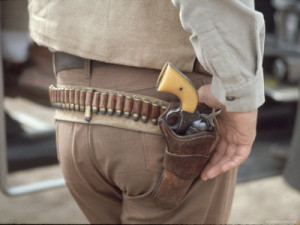 Some of this refers back to other carry methods; strong-side carry, cross-draw, or shoulder holster carry, for example. There are also Middle Of Back (MOB) holsters, ankle holsters, garter holster, bra holster, and pocket holsters, but I would like to confine this discussion to those about the waist. Each contributes to the complications of the draw stroke in their own way. The most common is strong-side right behind the hip with appendix carry coming up a strong second.
Some of this refers back to other carry methods; strong-side carry, cross-draw, or shoulder holster carry, for example. There are also Middle Of Back (MOB) holsters, ankle holsters, garter holster, bra holster, and pocket holsters, but I would like to confine this discussion to those about the waist. Each contributes to the complications of the draw stroke in their own way. The most common is strong-side right behind the hip with appendix carry coming up a strong second.
The position on the body is really dependent on your body shape. For me, appendix carry is out. I have carried on the strong-side behind the hip position for over forty years and have no need for a pistol pointing at my vitals for long periods of time – For that matter, no period of time.
There are advocates of the appendix carry and for them I say do as you will. My guideline is, “the thicker the waist and the bigger the belly, the pistol needs to be positioned further around the body.” I am at the strong-side, behind-the-hip station in life. What is most sad is to see those who believe that their belly is as flat as when it was when they were younger, and not only is their belly revealed more, but their carry as well.
The position of the holster on the body can impact the complexity of the draw stroke and that’s all I can say about that.
GUN BELT:
There are these belts called “Instructor Belts” or some such thing. Please reserve these for “Instructors” and wear a belt suitable for supporting your EDC. Aside from a good holster a well-made belt is tantamount to negating some complications of the draw stroke.
We have moved forward from simply sticking a firearm down the front of your trousers (although that is still done by some and they have paid the price for doing so). Belts came after trousers and gun belts came after trouser belts. Today, and for most civilian carry, the trouser belt serves the same purpose of a gun belt; holding and securing a holster that contains a handgun. When I was a LEO, my duty belt attached to my “garrison” belt with a set of “keepers” that surrounded both belts and kept everything pretty much on my hips. Today, as a civilian, I am more concerned with concealing my hand gun and a good belt helps me in doing that. I have worn a “liner” belt since my days as a LEO and it serves me well even today. However, there are belts available that are specifically designed and manufactured to support a heavy firearm; whether IWB or OWB in a good holster. They are dual-layered with a metal or polymer band between the two layers. This arrangement results in a very strong belt that will last through many years of use.I usually find that belts comes in too sizes; too big and too small. You are either pulling your stomach in to accommodate the belt adjustment or the belt is just one notch from preventing a pants-on-the-ground moment when carrying your favorite firearm.
I prefer the “liner” belt simply because the end attach with substantial Velcro material; I can adjust it where necessary and not bother myself with hole-spacing for the buckle. On average, my liner belts last about three years before I consider replacing them. However, due to their thickness, I have worn them for longer periods for IWB carry.
The issue with a belt that are intended to be used as gun belts as well as holding your pants up, is that they look like gun belts. However, gun belt manufacturers are doing better in making gun belts look like normal belts – and I commend them for that. After all, concealment of a firearm is concealment of a firearm and why should we provide a “tell” that we are concealing.
There is nothing more disconcerting to a concealed carrier or an open-carrier for that matter, to draw his firearm and the belt and holster travel upward upon the body until your hand is in your armpit. Again, we have much to concern ourselves with when drawing our Personal Defense Assistant (PDA) without worrying about the gear shifting.
OUTER GARMENTS:
 An outer garment is another factor in our search for the perfect draw stroke and minimizing some of the complexities in doing such.
An outer garment is another factor in our search for the perfect draw stroke and minimizing some of the complexities in doing such.
Normally, you will find me wearing a t-shirt and a not tucked-in outer shirt in the summer months and the same with an outer vest and/or jacket or coat in the colder months. Luckily, in the South, and for the most part, temperatures are not as extreme as in other areas of the country. My shirts are normally one to two sizes too large and I like heavier materials like denim – even in the summertime.
What I try to do is keep a direct line to the EDC for the hand to follow. Wearing a coat or jacket with a sweatshirt complicates things, because the shooting hand has to travel in different directions to access the firearm – up and back (up to clear the sweatshirt and back to push the jacket back out of the way. I have found that simply keeping one direction to the firearm is better. Depending on my outer wear, I can look like a “Bubba” or a businessman. One thing about being old is that nobody expects you to be fashionable and you can get by with some weird wear.
Plan your outer wear around your EDC. This includes gloves as well. There are some locations where gloves are essential to one’s well being and it is hard to pull a trigger with frost-bitten fingers. Simply, do the best that you can with what you got. This is about all that I can offer in this department.
Keep in mind that a firearm does you no good if you can’t reach it or can’t use it and you need to work things out for yourself accordingly.
OTHER SUPPORT SYSTEMS:
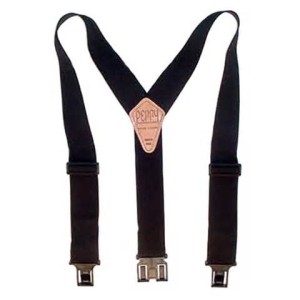 Have you ever noticed that you do a position check on everything from time to time? I have on occasion had to do that myself. However, I found one support system that helps alleviate position checks – suspenders. Yeah, I wear suspenders and a belt year round. Suspenders simply help me support the weight of a firearm, spare ammunition, cell phone, and defensive knife, and (sometimes) a small flashlight. My outer shirt covers everything and the suspenders do not interfere with the draw stroke.
Have you ever noticed that you do a position check on everything from time to time? I have on occasion had to do that myself. However, I found one support system that helps alleviate position checks – suspenders. Yeah, I wear suspenders and a belt year round. Suspenders simply help me support the weight of a firearm, spare ammunition, cell phone, and defensive knife, and (sometimes) a small flashlight. My outer shirt covers everything and the suspenders do not interfere with the draw stroke.
THE FIREARM:
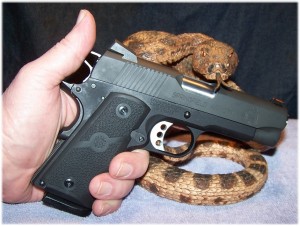 It seems that the rage these days is to pack as much firepower into the smallest and lightest firearm possible. I have heavy big handguns and I have light big handguns. I also have heavy compact firearms and I have light compact firearms. The lighter handguns are comfortable to carry; the heavy handguns are more comfortable to shoot – regardless of the size.
It seems that the rage these days is to pack as much firepower into the smallest and lightest firearm possible. I have heavy big handguns and I have light big handguns. I also have heavy compact firearms and I have light compact firearms. The lighter handguns are comfortable to carry; the heavy handguns are more comfortable to shoot – regardless of the size.
Pulling a heavy, large handgun from a holster takes more effort than pulling a light small handgun from a holster. Firing a heavy, large handgun takes less effort in controlling the handgun than firing a light and small handgun in common carry calibers like the 9mm, .40 S&W, and .45ACP.
I swap out my EDC frequently and have carried (and shot) heavy, large handguns and light, small handguns. While the light, small handgun is preferred for concealed carry I’ll take the heavy, large handgun for shooting any day. With that said, there may be times when a light, small handgun is preferred to carry out among the English. I know that this sounds like I am waffling around the subject, but the fact remains that regardless of the size and weight of the handgun, you must learn how, as efficiently as possible, get the handgun from the holster and then shoot it well.
I was recently was able to draw a comparison between the Springfield Range Officer Compact in .45ACP and the Springfield XDs 4.0 45. Both pistols are approximately the same weight and the same length, although the Springfield XDs 4.0 45 is one round less (5 rounds) than the Springfield Range Officer Compact in .45ACP. The Springfield Range Officer Compact in .45ACP was much pleasurable to shoot. The grip of the Springfield Range Officer Compact in .45ACP is longer than the Springfield XDs 4.0 45, where my little finger hangs off the butt of the pistol. Also, the texture of the Springfield XDs 4.0 45grip is more predominate than that found on the Springfield Range Officer Compact. I have to admit here that the Springfield Range Officer Compact was fitted with a Hogue rubber wraparound grip with finger grooves that soaked up a lot of recoil and provided me with a better purchase on the pistol. There is not much that I can do to the grip texture on the Springfield XDs 4.0 45 but to add something like Talon grips to “smooth out” the grip texture.
My shooting hand felt less “violence” against it with the Springfield Range Officer Compact, it pulled better from the holster due to the larger gripping surface, but was not necessarily faster to pull from the holster. In my mind, the Springfield Range Officer Compact is the better pistol for me to carry. With that said, a full size and heavy 1911-based pistol is my end-all carry. I have friends that carry a Glock 17 and a Kimber Ultra Carry II. It is all what the gun “toter” is comfortable with when it comes down to it.
In the end, it is not just what you carry but also controlling what you carry and not letting it control you.
Handgun Add-Ons:
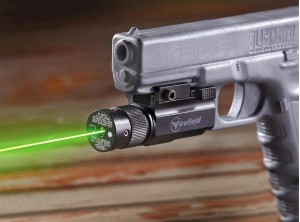 There is a plethora of “add-ons” for defensive pistols. There are many pistols, even compact ones, that have rails integrated into their design so that you can attach a laser, flashlight, to a combination of both to your carry pistol. Some pistols come with night sights and can be fitted with an RMR or other optical device. Aside from night sights, and possibly a grip-integrated laser, I would reserve other devices for house defense pistols only.
There is a plethora of “add-ons” for defensive pistols. There are many pistols, even compact ones, that have rails integrated into their design so that you can attach a laser, flashlight, to a combination of both to your carry pistol. Some pistols come with night sights and can be fitted with an RMR or other optical device. Aside from night sights, and possibly a grip-integrated laser, I would reserve other devices for house defense pistols only.
A grip-integrated laser is beneficial and does not drastically impede the draw stroke to any degree, because you grip the pistol anyway and which activates the laser. The carry handgun, in my opinion, should be a device free as possible. Part of the draw stroke is obtaining the proper sight picture and a good set of sights (night sight or not) is the best aid in doing so. The trigger finger (as others as well) have enough to do without being distracted by flipping a switch on a device to enable it. Note that competition shooters flip their switches prior to competition. You may not have that luxury in a real-life defensive situation.
Not only can lasers mitigate using the sights, they can also be used to affect the bad guy’s vision enough to distract him from his nefarious deed and provide you an advantage. The disadvantage of the laser (aside from revealing your position in a darkened room) is that the user tends to focus on the laser rather than focusing on the target with the laser and this impedes the draw stroke. The focus on the point of aim with a laser should be secondary to focus on the target. Another issue that I have witnessed with those who do not know how to properly run a lasers, is that the user will jerk the trigger, because the laser is bouncing around (and not rock steady like in the movies) thus mitigating any shot accuracy that the laser could provide.
PHYSICAL COMPLICATIONS:
 Physical complications regarding the draw stroke (and actual firing of the handgun) can stem from rheumatoid arthritis (RA), bursitis, tendinitis, carpal tunnel syndrome and missing appendages to name a few. Also, a short grip frame on a handgun can contribute to complicating the draw stroke. In colder weather, cold hands can cause some complexity where a grip is mildly textured and the same can be said when the hands are heavy with perspiration. Couple the aforementioned with a too large or too small a grip handle on the firearm and you have a lot to work around. I prefer a larger grip on a firearm to a smaller one.
Physical complications regarding the draw stroke (and actual firing of the handgun) can stem from rheumatoid arthritis (RA), bursitis, tendinitis, carpal tunnel syndrome and missing appendages to name a few. Also, a short grip frame on a handgun can contribute to complicating the draw stroke. In colder weather, cold hands can cause some complexity where a grip is mildly textured and the same can be said when the hands are heavy with perspiration. Couple the aforementioned with a too large or too small a grip handle on the firearm and you have a lot to work around. I prefer a larger grip on a firearm to a smaller one.
Along with the position of the handgun on the body, is the body structure itself. The wider the hip structure, the more likely the butt of the hand gun will dig into the side or will ride outward depending on the holster used. This may force the gun handler to grab the handle of the gun with fingers only and, as the gun clears the holster, follow up with the thumb to ensure a full grip. With the gun butt to tight against the body, the gun handler may also be forced to bend the body in an unnatural position in order to retrieve the gun. The proper holster cant and ride height can help to alleviate some of these things, but only so much.
Hand strength is another factor in complicating the draw stroke. Simply put, it is the ability to grip the handgun with a degree of strength necessary to fire the handgun. This includes not only gripping the firearms but also pulling the trigger (and pulling a slide on a semi-automatic pistol) and then managing the recoil of the firearm. Obviously, physical afflictions can exacerbate the complications of not only the draw stroke, but in controlling the firearm before, during, and after the shot. While a person may desire a larger-caliber handgun, a small caliber and lesser weight handgun may be the only choice. Semi-automatic pistols will naturally have a lighter trigger pull than a revolver and are easier to re-load than with a revolver. However, recoil of a light, semi-automatic pistol may be extremely uncomfortable and even painful to some.
I mentioned grip-integrated laser sights in the previous sub-topic. The ability to properly see the sights on a handgun, and to properly obtain a sight picture, is tantamount to accuracy and is needed for the complete draw stroke. Target identification is tantamount to safety.
Other physical complications like lack of body strength and muscle endurance also play into the draw stroke and subsequent aiming of the handgun. I watched a female shooter this past weekend that could not hold the pistol on target for more than a few seconds. As she was trying to sight in on the target, her arms kept dropping and she would quickly raise her arms to get back into position and try sighting the pistol again. Some shoulder and arm weight training would help her immensely. The pistol, a pistol that was too large for her hand (IMHO), was also twisting violently in her hands when it did fire. I felt bad for her because I could see her frustration.
SIMPLIFICATION OF COMPLEX MOVEMENTS:
With holster, firearm, and outer clothing out of the way, let’s get into the draw stroke itself.
The reason the pros perform the draw stroke so well as compared to us mere mortals, aside from hours and hours and hours of practice, is that they have simplified and streamlined the process. They perform just what is needed and do not perform what is not needed. There is very little body movement, the head and eyes are locked into the target, the pathway to the gun is clear, and the movements of the arms and hand has been fined tuned by repetitive muscle memory. As I heard once, “The professional does the same thing as we do; they just do it more efficiently.”
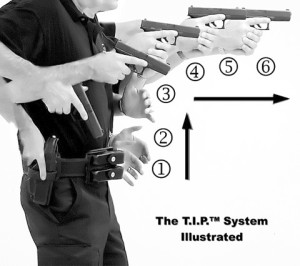 The draw stroke itself is a series of complex movements. The fact is that most of us are not professional competitors, and it is unlikely that we would achieve that status. We are everyday people who may be faced with a life or death situation and we should be training toward that possibility.
The draw stroke itself is a series of complex movements. The fact is that most of us are not professional competitors, and it is unlikely that we would achieve that status. We are everyday people who may be faced with a life or death situation and we should be training toward that possibility.
Obviously, the quickest path to the firearm is the one that offers the least resistance. For most of us, that means figuring out the fastest solution to get past garments. Not only do garments we wear factor in but also how the garments are worn.
When I attended the Bare Bones Gunfighting Course, the temperature was cold in the morning as we started the training. I was wearing a an un-buttoned flannel shirt, a “Barn” vest, and a hunting jacket, which meant that I had to push past three layers of clothing to get to my firearm and do so with only my shooting hand.
 I had been trained in the past to use my weak hand to fend off an assault while going for the firearm. If possible, I push the person assaulting past (invite them into the house and then invite them out of the house) me as I pivot to place my strong side (the gun side) away from the person assaulting, draw the firearm from its resting place, and bring it out and up to a shooting position while trying to move to a position on his blind side. If I use two hands to clear the pathway to the firearm, I am removing one line of defense – my left arm and hand.
I had been trained in the past to use my weak hand to fend off an assault while going for the firearm. If possible, I push the person assaulting past (invite them into the house and then invite them out of the house) me as I pivot to place my strong side (the gun side) away from the person assaulting, draw the firearm from its resting place, and bring it out and up to a shooting position while trying to move to a position on his blind side. If I use two hands to clear the pathway to the firearm, I am removing one line of defense – my left arm and hand.
If the person assaulting me is within “combat” distance (I place this distance at 15-yards typically), I may have time to get my firearm in action using good and proper techniques and assume a “combat” stance.
In warmer, or less cold, weather I normally wear an unbuttoned shirt and my “Barn” vest or some other vest of somewhat heavy material. I prefer denim shirts throughout the year simply because they are heavier than a standard dress or casual shirt and interfere less with the draw stroke. The point is to clear the dress, clear the draw, and present the firearm as quickly as possible.
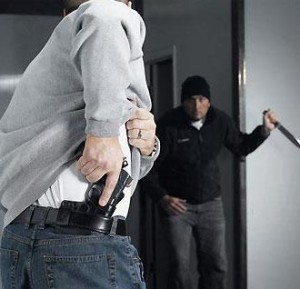 For me, wearing sweatshirts or buttoned shirts impede the progress to the firearm because it usually takes both hands to clear the path to the firearm, regardless of where the firearm is positioned on the body. Also, the firearm must be totally clear of any clothing to prevent snagging during the draw stroke. It is essential to have a least 99% of a grip on the gun when drawing it from the holster. The remaining 1% adjustment is made while bring the firearm to bear (dropping the thumb safety when needed and getting the weak hand in a good supporting position on the firearm, in my case) while moving (if I have not already moved) into a defensive shooting stance while trying to keep the person who is assaulting me as off balance as possible.
For me, wearing sweatshirts or buttoned shirts impede the progress to the firearm because it usually takes both hands to clear the path to the firearm, regardless of where the firearm is positioned on the body. Also, the firearm must be totally clear of any clothing to prevent snagging during the draw stroke. It is essential to have a least 99% of a grip on the gun when drawing it from the holster. The remaining 1% adjustment is made while bring the firearm to bear (dropping the thumb safety when needed and getting the weak hand in a good supporting position on the firearm, in my case) while moving (if I have not already moved) into a defensive shooting stance while trying to keep the person who is assaulting me as off balance as possible.
My draw stroke, if I can explain it, is once the firearm clears the holster, the muzzle is rotated forward as my shooing arm moves upward at an angel into the shooting position. A More modern technique is to draw the firearm straight out of the holster, bring it up to chest level with the muzzle at about a 45-degree angle, rotate the muzzle to the target, and then thrust the muzzle outward toward the target as the support hand comes up to assist. A variation is; while the firearm is at chest level at the 45-degree angle, to bring the support hand into position and then thrust the muzzle forward to the target. Both techniques work depending on the situation; if a bad guy is right on top of me, the latter works best because it keeps the firearm close to me and reduces the chance of a gun grab by the bad guy. The former works well if distance and time allows.
CONCLUSION:
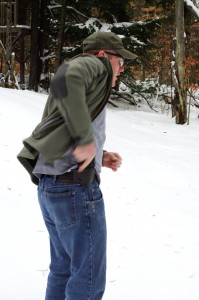 As I mentioned earlier, the pros do it better because they do what they do more efficiently. If you have a standard way of dressing, practicing the counter-offensive draw stroke around that is necessary to minimize the complexity of the draw stroke.
As I mentioned earlier, the pros do it better because they do what they do more efficiently. If you have a standard way of dressing, practicing the counter-offensive draw stroke around that is necessary to minimize the complexity of the draw stroke.
While at the range, I get to observe a person’s shooting habits. Some are pretty relaxed while others are very stiff. Most do not practice from the holster, but are simply there to hit the target. Most, I’m afraid, need a lot more practice before moving on to advanced practices like the draw stroke. I know of only two that practice from the holsters and they are either former or active LEOs. Besides me, they obviously know what really in store for them should they confront a bad guy or two.
Yesterday, I practiced some draw-stroking (with my training 1911) with my everyday attire. The day before, I practiced a bit while wearing a sweatshirt. I was way more efficient with my usual attire, but that was to be expected – and I am not fast by any means, but I want to be smooth by all means. There were a few times when I did not flip the thumb safety off or did not have my trigger finger properly positioned and that occurred when I was practicing the movement from the holster into the shooting position. I had to slow down and concentrate on the thumb safety and trigger finger position to happen when I wanted them to happen – even though I have been running the 1911 for over forty years.
Take every opportunity that you can to practice your draw stroke and take every opportunity to lessen the complexity of the draw stroke. They say that all good things come in time; however, they won’t if you don’t take the time. Each week, just spend some time perfecting a certain area of marksmanship; grip, stance, sight alignment, breathing, trigger control, follow through, etc. Then, begin folding those areas into the draw stroke. Don’t worry about speed; speed will come eventually. I have forced myself many times to slow down, concentrate, and try to work on muscle memory in all aspects of my shooting, analyzing how and what I do, and try to make things, well, more efficient. It seems to be never-ending and, in reality, it should be never-ending.RESOURCES:
Holster Cant – What You Can and Can’t do About it: https://guntoters.com/blog/2015/06/26/holster-cant-what-you-can-and-cant-do-about-it/
![]()


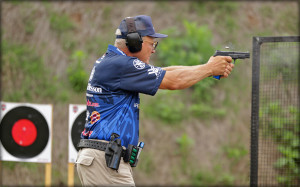
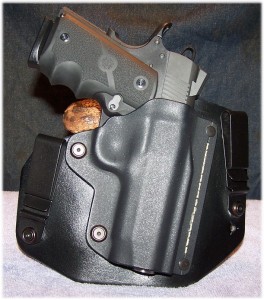

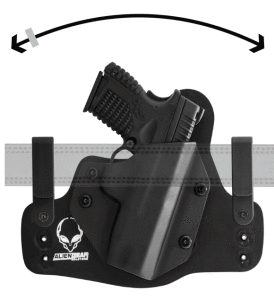

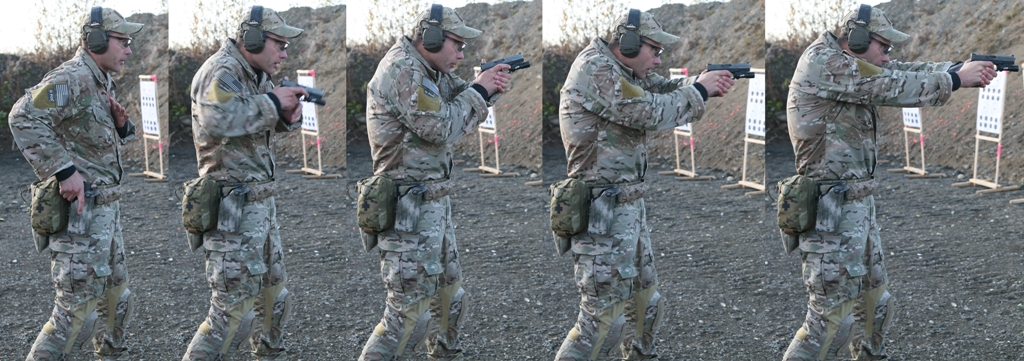
One Response to Complicating the Draw Stroke